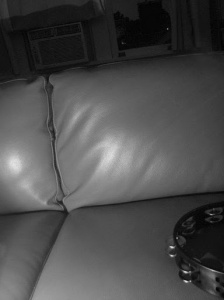I’m laying on my bed, listening to Sister Gertrude Morgan. Really, how can I be laying down under such insistence that I do something? “Let us make a record”, she shouts as her tambourine rattles and crashes. “Don’t you want to make a record?” she intones. “Prophet Isaiah made a record! Ezekiel made a record! Peter made a record!”
A record for Sister Morgan is heavier and higher than any piece of scratched vinyl or mere compact disc. Making a record is getting your hands dirty. Making a record is standing on street corners, taking in strangers, and bringing about God’s holy kingdom on earth as it is in heaven.
The fourteen songs of “Let’s Make a Record” are the only known recordings of the enigmatic street missionary. They are bare and unadorned. It’s just her and her tambourine, but with every striking word, with every shake of her tambourine, she consumes her listener in a great, righteous fire. In the liner notes to the album, the writer says that Sister Gertrude “battered Time itself with rhythms that intensified as the spirit took her”.
Some of her words are improvised, appearing as her tambourine, as perhaps even God, dictates. Some of the words are ancient and have been drifting in and throughout spiritual music since the days of slavery, taking on new contexts with each succeeding generation. She sings of John and his revelation. She sings of Christ, the living bread. She sings of Power.
Oftentimes, mid-song, Sister Morgan will start into a sermon: “So let us humble ourselves, dear ones, get ready for the new world. Prepare yourself to live in that holy city. That same city, that same kingdom, that Jesus was talking to His disciples about when He left them, gone on back to His Father. Don’t forget it! Amen!”
She became a familiar presence in New Orleans in the 1940s and beyond, easily recognized by her white nurse’s uniform (she was nurse to Dr. Jesus) and her unpolished, detailed paintings of Christ and the creatures of Armageddon that she created as visuals for her sermons. Standing on street corners, dressed in perfect white, holding up paintings or playing her guitar, she would preach from Revelation; a mysterious figure with a mysterious past.
William A. Fagaly, in his book on Sister Morgan (Tools of Her Ministry) writes that she was “the seventh child of Frances and Edward Williams, born on Saturday, the seventh day of the week, on April 7, 1900 in Lafayette, Chambers County, Alabama”. She was married for about ten years beginning in 1928, but strangely parted from her husband around 1937. This might of had something to do with the transforming revelations she was intermittently experiencing. In December of 1934, while alone in her kitchen, she heard the voice of God tell her, “I’ll make thee as a signet for I have chosen thee”. Three years later, around the time of her separation from her husband, she heard the same voice say, “Go-o-o-o-o, Preacher, tell it to the World”. She followed this voice to Opelika and Mobile, Alabama; and eventually to New Orleans, where she would spend the last 41 years of her life.
In New Orleans, she floated throughout the city, preaching and playing guitar on the streets of the French Quarter, taking in runaways and orphans as a missionary in Lower Gentilly. After a few years, she opened the Everlasting Gospel Mission in the Lower Ninth Ward, a white house of peeling paint and red brick surrounded by a lawn of four-leaf clovers.
Inside the mission, you would find rooms coated in white paint or blanketed in white fabric, symbols of purity. After being told in a revelation that she was the bride of Christ, she thereafter wore only white and decorated her home in white as a living example of her purity.
Hanging on the walls of her mission, sitting in corners, propped up on furniture, you would find blocks of wood, pieces of cardboard, Styrofoam trays painted over with Sister Morgan’s scenes of destruction and restoration. Scores of angels drift across her canvases. Winged beasts snarl and howl. Great buildings of the New Jerusalem rise and shine like gold. Scribbled sermons and verses fill every blank spot. And amid the chaos, there is usually a painted Sister Morgan, holding a Bible, or a guitar, or clutching the hand of Jesus; or soaring over the mess in an airplane, her bridegroom beside her, steering. “Jesus is my airplane”, she so often etched into her works in crude ballpoint letters.
Sister Morgan is probably known more for her paintings than for her music. It was through an art dealer named Larry Borentstein that she became somewhat famous throughout the art world as a relevant and honest folk artist. He opened his studio to the missionary, selling her works and giving her a corner to sing and play guitar. He is also the man responsible for organizing the recording of “Let’s Make a Record”.
I know of few recordings more captivating. There is true power in her words and delivery. She has convinced me that though the Church might require two or more believers, gospel music can be ferocious and mighty with only one intense voice.
Sister Morgan died in 1981 and now lies silent in an unmarked grave. Those who knew her recognized that she inhaled and exhaled the Holy Spirit with every breath. They say she never had conversations. She spoke only in sermons. When listening to her recordings, I remember that. I remember that the only thing that differentiates her songs from the rest of her life was a jangling rhythm…although, as I think about it more closely, I wouldn’t be surprised if her entire life wasn’t lived to something resembling a tambourine beat.
As for me, it’s time to get up. It’s time to do something.
Information was gathered from William A. Falgaly’s book, Tools of Her Ministry
and the liner notes to Let’s Make a Record
